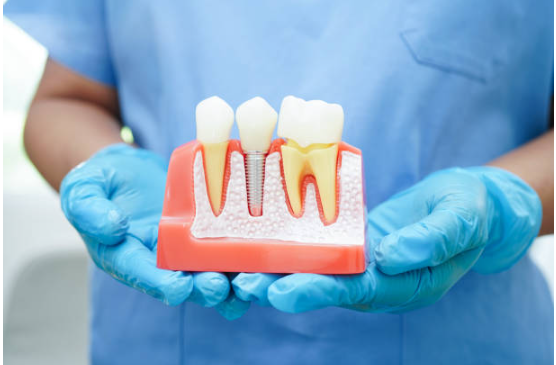Dental implant surgery is a procedure that replaces tooth roots with metal, screw-like posts and replaces damaged or missing teeth with artificial teeth that look and function much like real ones. This surgery can offer a welcome alternative to dentures or bridgework that doesn’t fit well and can offer an option when a lack of natural teeth roots don’t allow building denture or bridgework tooth replacements.
Here’s a general overview of the dental implant surgery process:
- Evaluation and Planning: Before the procedure, a comprehensive dental exam is conducted, including dental X-rays and 3D images, and models made of your teeth and jaw. The dental team will assess your oral health, and a treatment plan tailored to your situation is developed, which takes into account factors such as how many teeth need to be replaced and the condition of your jawbone.
- Tooth Removal (if necessary): If the tooth to be replaced is still present, it will first need to be extracted.
- Bone Grafting (if required): If your jawbone isn’t thick enough or is too soft, you may need bone grafting before you can have dental implant surgery. This is because the powerful chewing action of your mouth exerts great pressure on your bone, and if it can’t support the implant, the surgery likely would fail. The bone graft can create a more solid base for the implant.
- Dental Implant Placement: During the surgery, the oral surgeon makes a cut to open your gum and expose the bone. Holes are drilled into the bone where the dental implant metal post will be placed. Since the post will serve as the tooth root, it’s implanted deep into the bone.
- Bone Growth and Healing: After the metal implant post is placed in your jawbone, osseointegration begins. This process, where the jawbone grows into and unites with the surface of the dental implant, can take several months.
- Abutment Placement: Once osseointegration is complete, you might need additional surgery to place the abutment — the piece where the crown will eventually attach. This minor surgery is typically done with local anesthesia in an outpatient setting.
- Artificial Tooth Placement: After your gums heal, more impressions of your mouth and remaining teeth are made. The final tooth or teeth are then made and attached to the abutment.
- Recovery and Aftercare: After each stage of surgery, you may need to eat soft foods while the surgical site heals. Typically, your surgeon will use stitches that dissolve on their own. If your stitches aren’t self-dissolving, your doctor removes them.
The entire process can take many months from start to finish — three to nine months and sometimes longer. Much of that time is devoted to healing and waiting for the growth of new bone in your jaw.


